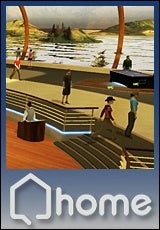It's no secret that PlayStation Home is one of this year's most anticipated pieces of software. After debuting to fanfare at last year's GDC, it's fallen into fairly hush-hush territory since, with occasional chatter about the software beta popping up every few months. Earlier today in a panel, James Cox, senior producer of Tools & Support, and Warren Keyes, lead programmer of Home Tools, unveiled the support section for developers interested in creating content for Home. The hour-long session, titled "Home Tools and Support: Creating Content for PlayStation Home" wasn't necessarily bursting with excitement for Sony fans, but it gave us some insight into exactly where Sony Cambridge seems to be production-wise, and what tools will be at developers' disposal.
Cox kicked off the panel with an overview of the software, which will give PS3 owners a virtual world to socialize within from the XMB, as well as a disclaimer that any of this content could change in the final software. He then began to describe the Home Development Kit, or HDK. It will allow game makers to implement 3D assets created in Maya or 3D Studio Max into the programs, configure and package them, and easily submit them online for evaluation and approval. The kit also provides editing software to allow devs to edit both objects and scenes, as well as put those elements into testing in both offline and online conditions.
Although we had little insight into the programming process for Home prior to the panel, the impression that Cox gave seems to indicate that many of the programming processes are done manually, and with this upcoming build of the dev kit, it will automate lots of things. The HDK will also include documents to help game developers with scene editing, creating both single-player arcade games and social mini-games, as well as guides for character and furniture creation. It seems that, based on Cox's speech, the last toolkit was 0.8, and the new HDK will bring the programming tools up to the 1.0 phase.
Besides the software in the toolkit, Cox mentioned some of the enhancements for the user experience in Home. Now, users (we don't know if this applies to the beta testers currently using the program) will be able to customize the clothing on their avatar and make their own designs. Arcade games and mini-games will be enhanced. Avatars can be loaded and saved. Cox also said that Havok will drive the software's physics. It will also become easier for developers to implement web-based content delivery.
Aside from a few minutes of more technical discussion, Cox showed off a video of how game launching currently works in Home. If this method ends up in the final version, you'll pull up your virtual PSP, go into its XMB, pull up the game you want to play, set the number of players, and launch into it. The gameplay options menu and HUD slightly resemble the menus found in another British Sony title, the SingStar franchise.






